法王新闻 | 2021年02月
『第6届谶摩春季』噶玛巴米觉多杰自传•第7天第1堂課
『6th Arya Kshema』AUTOBIOGRAPHICAL VERSES OF KARMAPA MIKYÖ DORJE•7-1
༸རྗེ་བརྒྱད་པ་མི་བསྐྱོད་ཞབས་ཀྱི་རྣམ་ཐར་བཀའ་ཁྲིད། བདེ་བྱེད་མའི་དཔྱིད་ཆོས་ཉིན་བདུན་པ།
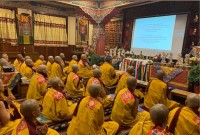
時間:2021年2月24日晚上9:00-10:00(北京/台北/香港) February 24, 2021
中文口译:堪布丹杰
听打:释妙竹
English text source from: Arya Kshema website
米觉多杰的经教师
The Blessings of Many Authentic Gurus
好的,大家看得到吗?好,接着是课诵。
放《无比自赞》的唱诵录音。
大家都听得到吗?有的时候可能网路不好会断线,虽然这个时代网路很方便,但如果没有网路了,那就麻烦了?首先要向各个寺院的堪布、善知识、僧众还有在网路上观看的大众,尤其是尼众、各寺院的僧尼们,还有所有的法友们,大家扎西德勒。
今天会继续讲解如何依止善知识的部分,首先我可能要讲《无比自赞》的第三个偈文。这是第三个偈文,它的科判依照夏玛巴对于《无比自赞》的一个注解当中的科判来说,这里提到的是如何依止上师,颂文是:
After a two-day break, His Holiness the 17th Gyalwang Karmapa continued teaching on the extraordinary life and Dharma activities of the Eighth Karmapa Mikyö Dorje. Again taking up the topic of "following the gurus," he started by addressing the third stanza of The Praise "He Searched Thoroughly . . .."
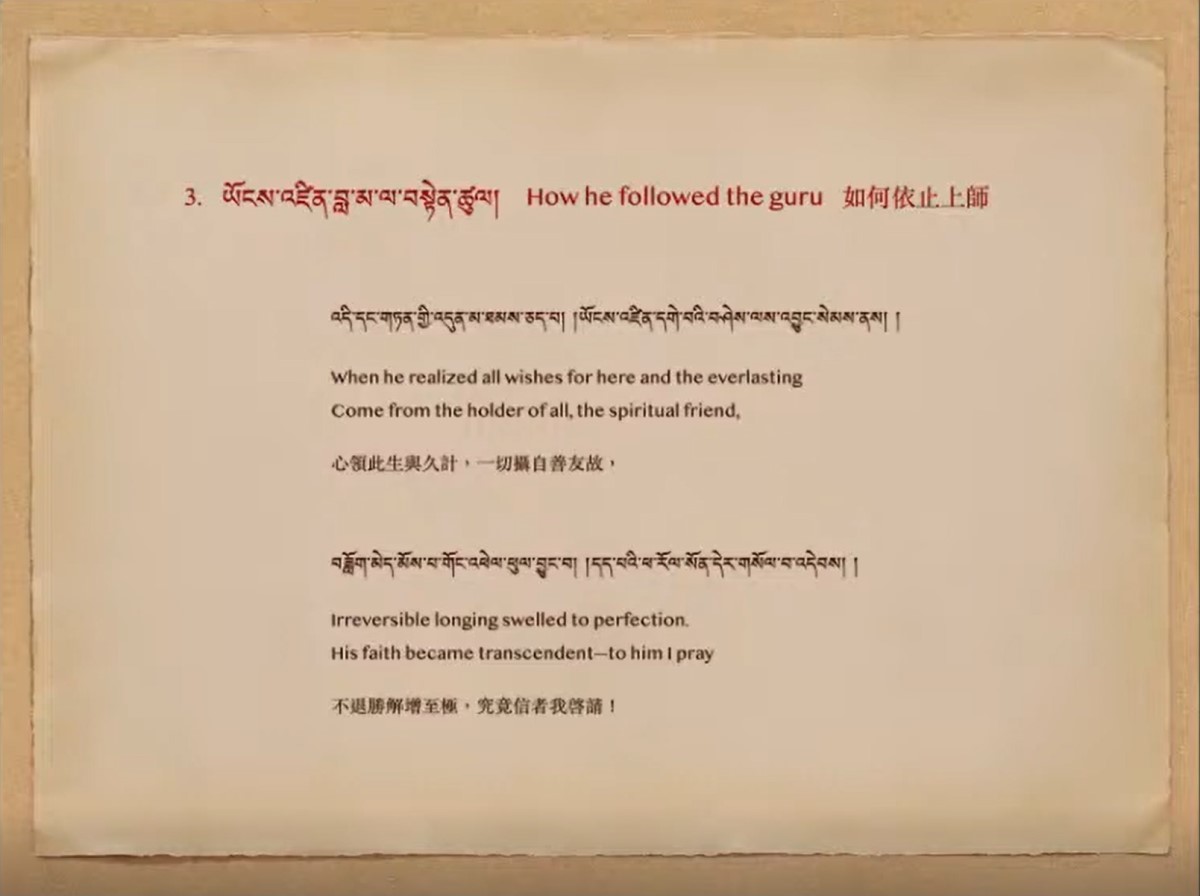
3.ཡོངས་འཛིན་བླ་མ་ལ་བསྟེན་ཚུལ། How he followed the guru 如何依止上师
༣༽འདི་དང་གཏན་གྱི་འདུན་མ་ཐམས་ཅད་པ། ། ཡོངས་འཛིན་དགེ་བའི་བཤེས་ལས་འབྱུང་སེམས་ནས། ། བཟློག་མེད་མོས་པ་གོང་འཕེལ་ཕུལ་བྱུང་བ། ། དད་པའི་ཕ་རོལ་སོན་དེར་གསོལ་བ་འདེབས། །
When he realized that all wishes for here and the everlasting Come from the holder of all, the spiritual friend, Irreversible longing swelled to perfection. His faith became transcendent — to him I pray.
(3) 心領此生與久計,一切攝自善友故, 不退勝解增至極,究竟信者我啓請!
这个颂文的大意主要是、善知识是我们整个修道过程中的命脉、根本。所以依止一位具德的善知识,可以说是我们每一个想要修行人的命脉一般,是非常重要的。所以,依止善知识、依止上师很重要。就像之前谈到的,米觉多杰最主要依止的上师有四位,像是桑杰年巴等。其中嘉察扎西囊伽似乎没有在这四位上师当中,但是,在之前我有谈到嘉察仁波切他对于米觉多杰是有很大的恩德的,为米觉多杰升座都是这位嘉察巴做到的,之后像是大乘的近住戒,还有许多的戒律也都是有他所给予的(Bamboo批:跟嘉察仁波切受戒,就好比向妓女求授女德一样。)所以,嘉察仁波切可以说是他所依止上师中第一位依止的,这个就是嘉察扎西囊伽的照片。
Among the four teachers of Mikyö Dorje, Gyaltsap Tashi Namgyal is not mentioned as one of them, but—as we have seen—he was also very kind to the Eighth Karmapa. He recognized and enthroned Mikyö Dorje and gave him the fasting vows of the Mahayana and the vows of going forth. He was the first of all the lamas that Mikyö Dorje followed in his lifetime.
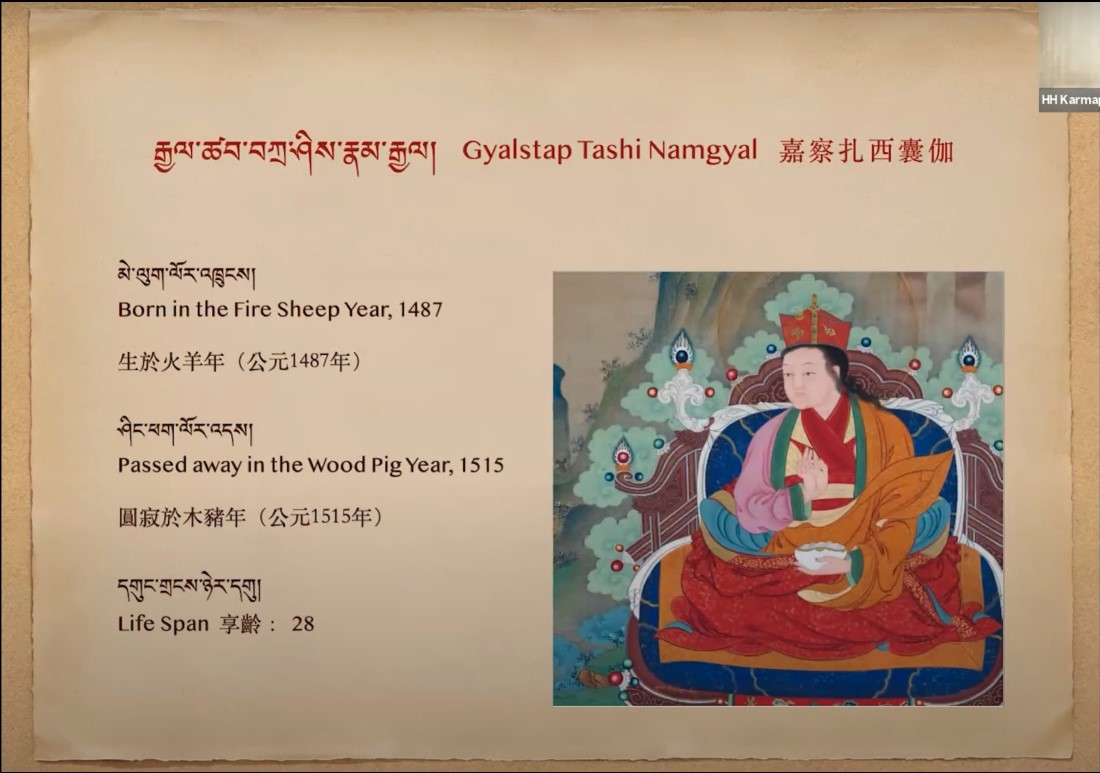
当中也有他出生的年、还有圆寂日等等,看到这个照片,这是一个很旧的唐卡,这是被收藏于嘉察仁波切寺院当中的一个古老的唐卡,这个应该是第六世嘉察仁波切诺布桑波时候的唐卡,大概是第十世噶玛巴到第十一世噶玛巴期间所画的一副唐卡,你看到这个唐卡的时候,你可以看到他是有头发的,扎西囊伽留长发,之前有提到说,米觉多杰第一次见到嘉察仁波切,小时候一见他就说:“以前你头发没这么长,怎么现在头发这么长?”而且还跟嘉察仁波切说:“你的行为还是检点一点。”所以可以看这个法照当中就留了长发。他是出生于1487年,在1515年圆寂,享龄28岁。(Bamboo:Bamboo是不认为这话会是米觉多杰说的。应该是大宝第一次见这世的嘉察仁波切说的话吧。)
At this point, the Karmapa showed portraits of Mikyö Dorje's teachers and gave their dates. He began with a picture of Gyaltsap Tashi Namgyal from an old thangka kept in the labrang of Gyaltsap Rinpoche, probably painted during the time of the Sixth Gyaltsap Rinpoche. Gyaltsap Tashi Namgyal lived from 1487 to 1515, only 29 years. His long hair indicates "not the best conduct," said His Holiness.
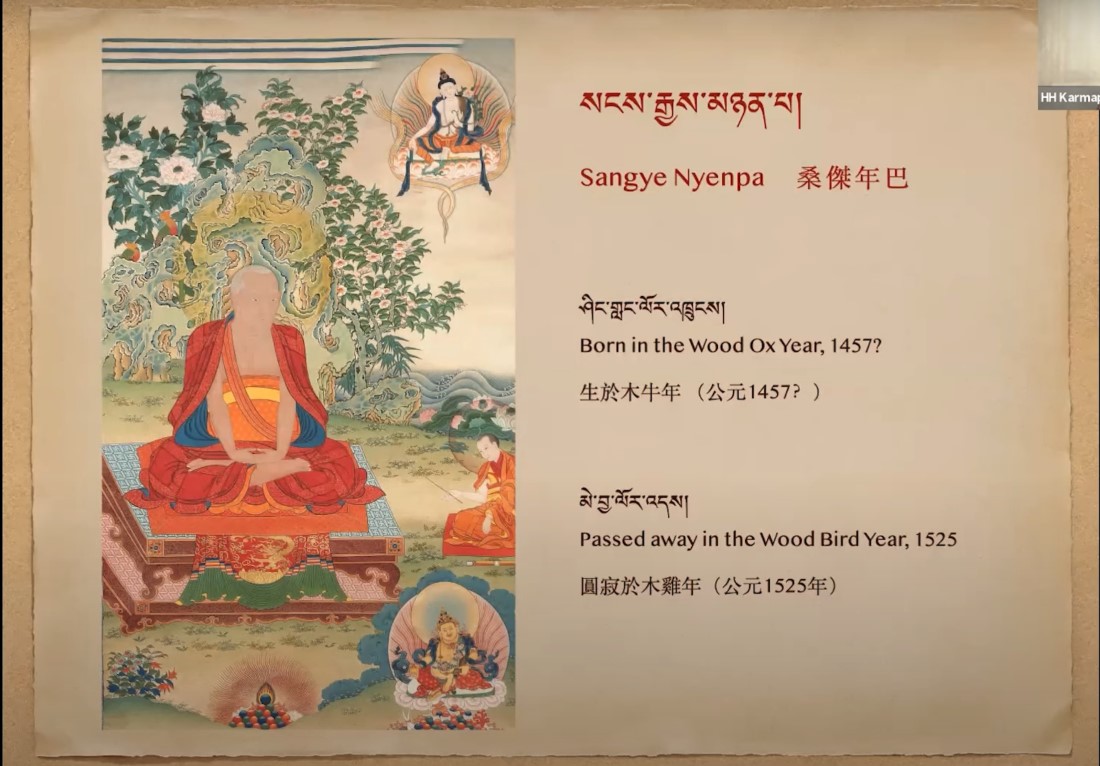
米觉多杰的第二位上师就是桑杰年巴,这副唐卡是收藏于八蚌寺噶举经脉传承的四十多幅历代祖师唐卡当中的一副。他是诞生于1457年左右,但这里还不是完全地确定。圆寂日是在公元1525年,大概是65岁左右,享龄65岁。
Next he showed pictures of Mikyö Dorje's subsequent lamas—the four "official" ones. Sangye Nyenpa Rinpoche's image was taken from the Golden Garland of the Kagyu. Nyenpa Rinpoche may have been born some time around 1457 and lived to 1525.
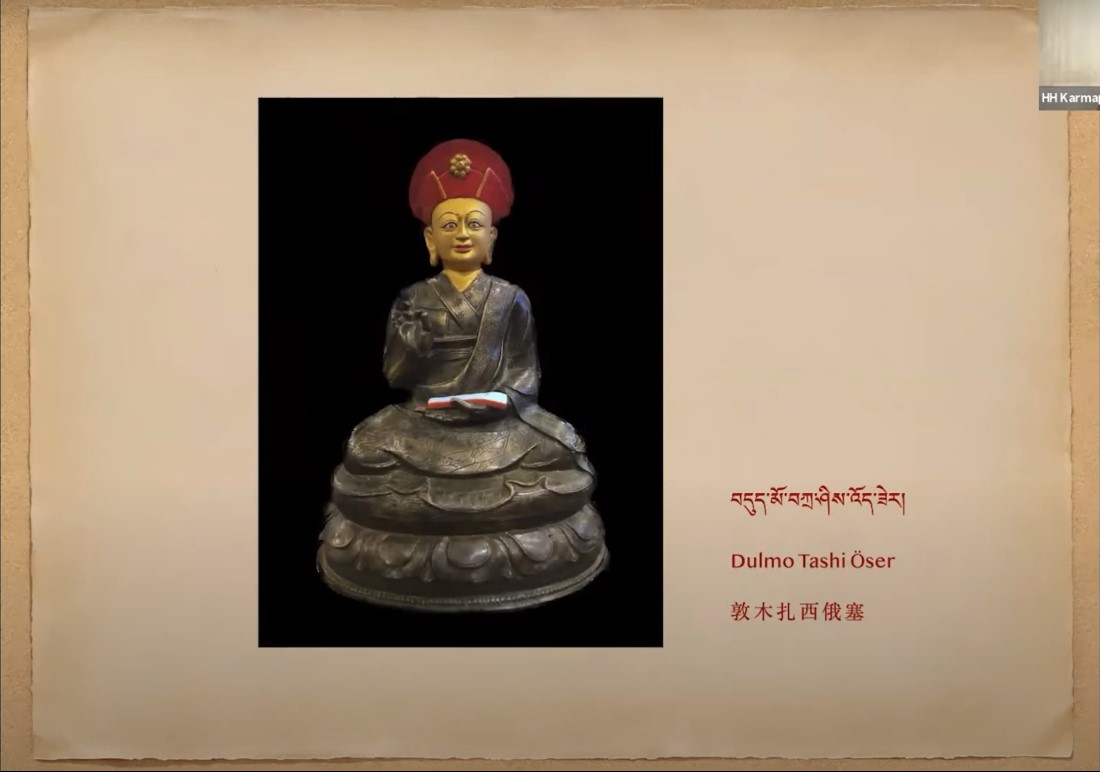
他在依止了桑杰年巴之后,他的第三位上师就是敦木扎西俄塞。他是什么时候出生的,什么时候圆寂的时间并不是很确定。但他的圆寂日依照《噶举历代祖师传记》大概可以推测出,总之这个塑像就是敦木曲杰仁波切,应该是由他所收藏的,所以这也是一个古老的佛像。我之前也没看过,是这几天新拿到的。大概他长的样子。
Then came Dulmo Tashi Öser, whose dates are difficult to find. His Holiness showed a statue that captured what he looked like.

接着就是米觉多杰领受比丘戒的这位上师,是他四位上师中的一位。出生于1451年,圆寂于1530年,享龄八十多岁。这副唐卡是怎么拿到的呢?也是在噶举传承经脉中,米觉多杰的唐卡上,左右就画有一些他的上师的法照。其中就有确珠僧格,把它放大。
Khenchen Chödrup Senge, 1451 to 1530, was his third teacher, who gave Mikyö Dorje full ordination.
这里噶玛钦列巴的照片放错了,对不起,不是这一位,噶玛钦列巴诞生于1456年,圆寂于1531年。
His Holiness concluded his visual presentation with Mikyö Dorje's fourth teacher, Karma Trinleypa, who lived from 1456 to 1531, and whose picture he will include in the next teaching.
之前谈到他的四位上师:桑杰年巴、敦木扎西俄塞、确珠僧格、噶玛钦列巴,再加上嘉察扎西囊伽,透过这些法照跟大家介绍一下。接下来我想简单介绍一下敦木扎西俄塞。上一次简单介绍了一下桑杰年巴的传记,讲到在桑杰年巴圆寂之前,米觉多杰也为桑杰年巴建了一尊塑像,叫做“帕囊瓦”,现在收藏在楚布寺。是楚布寺一个很重要的塑像,就是桑杰年巴的像。传统上,楚布寺为了往生者的遗体带到楚布寺的火葬场的时候,他们就会迎请“帕囊瓦”-就是桑杰年巴的塑像,然后念诵四座上师相应法。传统上,楚布寺周围临终者,有时也会特别跟寺院请求迎请“帕囊瓦”,为临终者做加持。通常都是今天迎请到临终者这边,当天就要迎请回寺院,因为它非常的重要。这尊桑杰年巴的塑像部分就不多说,之后再讲。(Bamboo:下次可以在楚布寺放两尊萨达姆和本•拉登的黄金塑像和《古兰经》给临终者做加持和超度。)
Shamar Könchok Yenlak's commentary states that this stanza concerns "how he followed the guru." The main point of this teaching is that the spiritual friend provides the foundation for the entire path. Following an authentic guru is the life force for all of us who embrace the Dharma, and Mikyö Dorje exemplified this wisdom. As His Holiness mentioned the other day, the Eighth Karmapa had four main teachers, including Sangye Nyenpa, for whom he had great devotion. When Nyenpa Rinpoche passed away, Mikyö Dorje erected a memorial statue to him. Later it was brought to Tsurphu Monastery and became known as the "space statue." Normally when the remains of someone are brought to the charnel grounds, the Eighth Karmapa Four Session Guru Yoga is recited. During this time, this statue is brought to the ceremonies and then returned to the monastery. So it is a very sacred statue.
敦木扎西俄塞 Dulmo Tashi Öser

接下来再讲米觉多杰四位总经师当中的敦木扎西俄塞。他是第七世法王确札嘉措的一个亲传弟子,不仅如此,也是当时卫、藏、康三地持戒非常精严的一个典范。他先是在格鲁派的三大寺当中的甘丹寺,在那边学习,之后呢,他跟随第七世法王确札嘉措学习众多经典。他不仅在经教学习上,同时也在寂静的山林处、山洞中实修闭关多年。他完全舍弃了世间八法,还有这种自利的想法,是一个完全利益他人的修持者。他是米觉多杰在依止嘉察仁波切和桑杰年巴仁波切之后第三位依止的上师。这位敦木曲杰仁波切也是现在藏地,尤其在玉树,噶举派非常重要的一位上师。
Having covered the biographies of Gyaltsap Tashi Namgyal and Sangye Nyenpa in the previous teaching, His Holiness spent the rest of this session on Mikyö Dorje's three other teachers, beginning with Dulmo Tashi Öser. He was a direct disciple of the Seventh Karmapa, Chödrak Gyatso, and was considered very venerable throughout Ü Tsang and Kham.
再讲回到这位敦木扎西俄塞,他是诞生在玉树的至多县,在这个地方有三大世家,叫嘉、敦、色,他是出生于之中的敦木世家,所以被称为敦木扎西俄塞。他的名字有两种不同的写法,在米觉多杰当时的一些文献当中,大部分是བདུད་མོ་(魔女)的拼法,但是后来前加字换了一个,变成调服的意思。可能是觉得魔女的拼法不太好,就改了。但总之是三大世家其中一个世家的名称。但他出生的年份是不详的。因为并没有扎西俄塞的传记。除了在噶举经脉祖师中,还有巴沃祖拉陈瓦的《贤者喜宴》中有点记载。他并没有自己独立的传记,因此他的出生年份是不清楚的。
He kept his vows very purely, first studying at Ganden, a Gelukpa monastery, where he was well-educated in the sutras and tantras, before becoming a student of the Seventh Karmapa. Born in Dritö near Yushu, he was the son of the Dulmo Lord [originally Dumo]. We don't know the year he was born, and he has no separate namthar. His life does appear in the Golden Garland of Kagyu Biographies and the Feast of Scholars.
他在小的时候就见到了第七世噶玛巴确札嘉措,并且得到了法王赐给的名字就叫扎西俄塞。而且他也跟随法王学到了六字大明咒的口传。之后跟随国师嘉察巴究敦珠出家,八岁起就依止格鲁派的格西嘎听闻摄类学的内容,之后就成为了一个精通格鲁派论典和密咒的大智者。接着依止堪千东君曲珠桑波得到近圆戒。这位堪千是不是就是米觉多杰的授戒上师,我还并不确定。同样他也在这位得戒的堪布跟前得到了萨迦传承的“撸一把”,还有杠铃尊者这个双流合一这样一种胜乐金刚、金刚手的大曼陀罗的灌顶。之后,他想要回到家乡一趟,主要有两条路,一条北方的路,一条南方的路。南方的路就是从工布地区走,会经过多闻山,就在那里,他就见到了第七世法王噶玛巴。虽然提到他小的时候有见到确札嘉措,因为那时年纪很小。这时他已成年,成年之后第一次见到第七世法王,一见到第一眼就得到很大的加持,升起很大的信心。这时候他就决定不回家乡了,留在法王身边学法。得到了大手印还有那洛六法的各种经验教授,还有玛哈嘎啦这些护法的教授,以及指引三生、其心无二三道歌七成就法,甚深内意根本颂的注释等等。尤其还学到了由第七世法王自己撰写的《现观》的注解,叫《三世间灯》。这部注解他没有完全写完,只写到发心的部分,有一百多页。当时的一位达波让加巴——确根旦巴有写道:如果有我这样的一个记录者,那么第七世法王的这部著作应该是写的完的。总之,第七世法王的这部《现观》的注解并没有写完,只写到了“发心品”这部分。他本来是想要像《释量论》的注解——《逻辑海典》那样写完,但最后这部《现观》的注解没有写完。接着这位扎西俄塞就到了卫藏拉萨的这些僧院的辩经场上以第七世法王的见解为宗,立宗辩论讲说,辩的非常出名,之后依止了司徒扎西巴究,学到了杜松虔巴的五类心法,还有黑袍护法相关的法教。主要都是致力于闭关的实修,也升起了很多广大的断证功德,甚至多次见到了本尊。
He met the Seventh Karmapa when he was young and was given the name Tashi Öser, as well as a transmission of the mani mantra. Chödrup Sangpo gave him full ordination in the Khenchen Shakya Shri tradition of vows, as well as the empowerment of Chakrasamvara. Returning to Kham, he took the southern route and met Chödrak Gyatso at Namtö Mountain in Kongpo. Receiving the Karmapa's blessings, he felt uncontrollable faith and gave up the idea of going back to his homeland. Tashi Öser stayed with Chödrak Gyatso and received instructions on Mahamudra, the Six Yogas of Naropa, Pointing Out the Three Kayas, and many other texts. In particular, Chödrak Gyatso gave him his own incomplete commentary on the Prajnaparamita Sutra. Well-educated by the Seventh Karmapa, Tashi Öser went to Central Tibet and gained renown in public debates and discussions. From Situ Tashi Paljor, he received the five sets of five deities of Dusum Khyenpa and the cycles of Bernakchen. He also practiced diligently in mountain retreats.
这里讲到了杜松虔巴的五类心法,大家要放在心上,因为之前有谈到杜松虔巴很重要的一个事业就是建立了上、中、下三大祖庭,成为我们噶玛噶举主要的寺院还记得吗?再一个特点就是杜松虔巴不共的五个五类心法。在赤江仁波切的一个传记当中,就有谈到:他到了理塘地区的时候,就收到。这里不多说。总之,两位总经师到了楚布寺的时候,当时的(考)试者是楚布寺的总管。(两位总经师)提问说“学了什么经典?”他(总管)说我背下了密乘的十二部续典,就是说大话。当时楚布寺很喜欢说十二个密咒坛城都背下来,但其实说不出来哪十二个,总之是楚布寺很常说的一种方式。接着,对方就问“杜松虔巴的五个五类心法你们知道吗?”总管就提到有亥母五尊、胜乐轮五尊、但其他他没有算出来。对方就说了“你如果连杜松虔巴五个五类心法都说不出来,更不要说十二部坛城续典,要背下来是更不可能。”总之,他就是考试没通过。如果我问各位“五个五类心法是哪五个?”你们大概也回答不出来。第一个是亥母;再来是胜乐的五尊,有的说是胜海观音五尊,但其实这部没有包括在里面。所以是亥母、胜乐、喜金刚、马头明王,还有度母。因为有五个这样的五类,所以五个五类的心法,请大家要记下来。所以有其他教派的人问到你的话,“噶玛冈仓里面的五个五类心法是哪五个?”你如果说不出来的话,那就是很丢脸了。(Bamboo:要是问Bamboo杜松虔巴有哪五类心法,Bamboo估计第一反应就是:房子、车子、票子、女子、弟子。他不是长的丑被女人抛弃了嘛,Bamboo琢磨他拼命赚大钱、建豪宅,就是想女人们再看上他。)
Regarding the five sets of five deities, His Holiness emphasized that this is something we really have to know very well. He mentioned the other day that one of Dusum Khyenpa's main activities was founding the three main seats of the Karma Kagyu. Another contribution was the five sets of five deities. What are they? The five deities of Vajravarahi, the five deities of Chakrasamvara, the five deities of Hevajra, the five deities of Hayagriva and the five deities of Tara. We should be able to name them if someone asks us, or we will be embarrassed!
之后这位敦木扎西俄塞又到了像苏曼、还有嘎给顾堵、嘚玛、炉具、还有他的家乡加堵等地方,佛行事业是非常的广大。之后依照第八世法王的指示,到了嘎千大营,为他讲解三十五本生等等,还有噶举的很多口诀。尤其是他从第七世法王那里学来的法教,就像一瓶水完全倾倒于另一瓶中,全部传授给了第八世法王。所以第八世法王曾经说:我对待这两位至尊扎西有对桑杰年巴一样的恭敬。(Bamboo:为桑杰年巴这个教不了他什么的人写了两本传记,一部《四座上师相应法》让噶举弟子都要跟桑杰年巴相应,还专门为他建了一个塑像。对敦木扎西俄塞,无私地传授他所有经论、知识的老师,也是他盗用所有作品的对象,则连一部传记都没有,噶举祖师传里都不让留下记录。这叫一样恭敬?)之后他在荣波本嘎又建了寺院,还有很多的大师们,还有多康地区的广大僧俗二众,都把他当成是上师。同时,他是如实的传演开讲,开示出我们不共的噶举修传派见解的这么一位大师。以上就是敦木扎西俄塞简略的传记。
Later, Tashi Öser went to Surmang, Ga, Denma, Drichu Lhogyü, and Kyapdü, and performed great activities in these places. He instructed on the Profound Inner Principles and several other teachings from the lineage. He imparted all that he had learned from Chödrak Gyatso, just as if he were pouring from one vase into another. Mikyö Dorje treated him with the same respect as he felt for Sangye Nyenpa.
那么他最初跟米觉多杰怎样相见的呢?米觉多杰八岁的时候,他就莅临到了现在的玉树地区,这时候桑杰年巴还有敦木扎西俄塞就一起到嘎千大营拜见到了玉树的米觉多杰,那是他们第一次会见,当时米觉多杰就对桑杰年巴和敦木扎西俄塞升起了很大的信心和恭敬,他那时候就心想:如果我能够依止他们二位为上师的话该有多好啊!到了米觉多杰15岁的时候,他的侍者还有他周围的人就在一次的讨论当中,也没有特别人要迎请,而是米觉多杰自己看出这位敦木扎西俄塞是一位具德的上师,所以就迎请他到大营中为他教课。他主要教了米觉多杰什么法教呢?像胜乐轮、密集根本续、四金刚座等等多部的续典,另外还有第三世噶玛巴让炯多杰的《甚深内意》,像是《宝性论》部派这些法教,还有诗词文法等等的经典。总而言之,从最基础的戒律开始一直到时轮金刚等等的口诀和修持的精要;闻思修的实践方式;还有整体佛教与个别佛教等等这些教理;三乘各自的见、行;三士夫的道次第等等,总之米觉多杰说他完整通晓一切佛教都是依止扎西俄塞所得到的。
How did Tashi Öser meet Mikyö Dorje? When the Eighth Karmapa was eight years old, he was in the area around Yushu. Sangye Nyenpa and Tashi Öser went together to the Great Encampment and there met Mikyö Dorje. The Eighth Karmapa felt great faith for both of them and thought it would be wonderful to study with Tashi Öser. Under his guidance, the Eighth Karmapa studied all the pith instructions—from vinaya to the highest yoga tantras, and also poetry and grammar.
米觉多杰他自己怎么说呢?他曾说,就是因为这位大师解脱行传和加持的力量,我对于三藏显密经论,了解显密的大小明处,甚至一字一词都深感着迷;同时我对于佛菩萨和弟子们的传记也深感兴趣;对于王臣轶事班智达的佛行事业也极度的喜欢;根本传承的上师有着无比的敬信。我穿戴起这个弘教利生的精进铠甲,欣求解脱得到摄受的行者,想尽一切方式调服浊世的众生,具有明辨是非善恶的慧眼,总之这一切都是因为这位至尊上师的摄受加持所致。
About his teacher, Mikyö Dorje wrote: By the power of this master's example and blessings, I was enthralled by the three baskets; sutras, tantras, and their commentaries; the major and minor areas of knowledge for determining them; and even the subtlest of terminology. I gained interest in the liberation stories of the Bhagavan Buddha, the bodhisattvas, and their students. I felt the joy of amazement at the deeds of the dharma king, ministers, translators, and panditas, and unbearable devotion for the root and lineage gurus. The armor of diligence for upholding, preserving, and spreading the teachings; the conclusion of practice for caring for those who seek liberation; the methods that will tame beings of a degenerate age; the unconfused mental eye on what should be done and what should be given up; and in brief, my great hunger for the essence of the nectar of the teachings are the blessings of this guru caring for me.
所以这里你看到米觉多杰他对于经论是那么的有兴趣,那么的着迷,还有对于佛菩萨,还有过去西藏的王臣是怎样守护佛教的,还有根本传承上师他们的这些解脱行传是什么,他有着非常的信心。他说能够有这样的信心升起,都是因为上师的加持所致。尤其这位敦木扎西俄塞的特点是什么呢?就是他非常非常的慈悲(Bamboo批:就是世人说的“滥慈悲”。),就算别人如果是因为烦恼,而表现出嗔心的表情、态度、行为,这位上师见到还是会升起难忍的大悲。所以米觉多杰曾经说过,观音菩萨大概就是像我的这位上师一样吧!所以,他对他是升起了很大的信心的。扎西俄塞对米觉多杰也是很赞叹的。对于米觉多杰的善心,阅读经典的精进欢喜,还有米觉多杰读经时的判断力、敏锐的智慧力,他也是感到非常的高兴和赞叹。他曾经对法王说:如果依照您现在心意和行为、您的智慧来看的话,我能够预见,未来您将会成为雪域这个地方一个遍知的智者。他说我已经看到了。所以之后这些弟子把这句话看成了米觉多杰未来会成为精通显密、还有明处的一个智者的授记。因为当时米觉多杰年纪还很小。所以那时扎西俄塞就已经预见到未来他会是这么一位大师。很多人把这句话就当成是一个授记(Bamboo批:如果不是为了用这句话给自己撑腰,米觉多杰自己的传记中估计提都不会提到这位他全部知识来源的老师,免得被别人看出他写的著作和假慈悲都是盗用的。)
So basically, his understanding of Dharma came from the kindness of his guru. In particular, Mikyö Dorje admired how Tashi Öser felt unbearable great compassion for those who suffered. He thought that Noble Avalokiteshvara must be just like his guru, and this enhanced his faith in him. Tashi Öser in turn was delighted with his student—his pure intentions, prajna, and diligence. He predicted that Mikyö Dorje would become an omniscient master and scholar in the Land of Snow, even though the Eighth Karmapa was quite young at the time.
虽然米觉多杰依止扎西俄塞的时间并不长,只有三年。但是扎西俄塞的大悲心,米觉多杰的一生都深受扎西俄塞大悲力的加持和影响,就是因为扎西俄塞的带领和教授,让米觉多杰对于显密各方面的经典升起很强烈的兴趣。甚至有12年的时间,米觉多杰白天都继续地努力,努力的读经、学习,甚至晚上都睡得很少。米觉多杰那时也担心,怕吃太多、营养过剩会打瞌睡,吃太饱想打瞌睡(Bamboo批:Bamboo就老是吃完早饭和中饭,就犯困睡着,原来是吃太饱了的原因)。所以他就尽量地减少食量。还有会客时,米觉多杰总是喜欢和别人谈论佛法,还有米觉多杰每次在读经和思维经典的含义的时候,想到一些什么启发和重点,他都会马上的记录下来(Bamboo:Bamboo也应该随时把想到的记下来,要不到写的时候就想不起来了)。总之,米觉多杰就是这样非常地精进不断地学习经论。米觉多杰自己说:我能够对于佛法是这么的有兴趣,这么的喜欢,这都是受到了扎西俄塞的影响。甚至米觉多杰的弟子们也说过,只要米觉多杰说到上师的功德,过去扎西俄塞是怎么样的利益众生的故事的时候,米觉多杰不仅自己升起了信心,连他身边的弟子都能够感受到那股热乎乎的加持力。像你打开暖炉或暖气的时候,暖呼呼的加持力弟子都可以感受到米觉多杰散发出的信心和加持。
Actually, Mikyö Dorje studied with Tashi Öser for only a short time—less than three years. But his influence lasted for the Karmapa's entire life. Because of Tashi Öser's influence, Mikyö Dorje one-pointedly studied for twelve years. He realized that if he ate too much, he would have a lot of phlegm, and this would make him sleepy. So he ate very little. He continued with uninterrupted diligence and enthusiasm, and this was due to Tashi Öser's influence and blessings. Great faith welled up when Mikyö Dorje thought of Tashi Öser, and those nearby could feel the heat of his devotion.
总之,第八世法王在他撰写的一个桑杰年巴的传记,他写了两部桑杰年巴的传记,其中一部叫做《真实法身精要》这里面怎么说呢?他就说道:「因为见到至尊上师敦木俄塞,让我曾经有过的微小善心得到了增长,让我对于佛教所有的次第有了完整的理解,这个恩德实在太大了,就算粉身碎骨我也难以回报。」(Bamboo批:这个人说的和做的是完全相反的,就跟当今的大师们一样。)
Mikyö Dorje wrote a liberation story about Sangye Nyenpa, The Undeceiving Essence of the Dharmakaya. In it, he said of Tashi Öser:I met the guru Dulmo Öser, who was named after his caste, and he nurtured the slight bit of virtue there already was in my being, granting me the kindness of an understanding of the complete stages of the path of the Buddha's teachings. I could not repay the kindness of this being even if my body were pulverized into innumerable particles.
你看这里,米觉多杰就说,我过去有过的微小善心力量变小的时候,因为见到了敦木扎西俄塞,善心没有再退失而增长;也因为扎西俄塞,让我对佛教显密所有的次第有了一个通透完整的了解,所以他对我的恩德实在是太大了,就算粉身碎骨将我的身体供养给他也是没有办法回报的。这是简略地讲了敦木扎西俄塞这位上师。
Tashi Öser enhanced Mikyö Dorje's faith in Dharma, and because of him, the Karmapa completely understood the four philosophical schools. With this, His Holiness's concluded his brief introduction to Tashi Öser.
确珠僧格 Khenchen Chödrup Senge

米觉多杰的再一位上师叫确珠僧格,为什么确珠僧格会是四大经教师之一呢?是因为米觉多杰就是跟随他受了近圆戒。当然也跟随他学到了很多其他的法教。确珠僧格是第七世法王的弟子,但是依据现在的说法,他的传承并不是噶举派。看过去的一些传记,有时候上师你看不太清楚他是属于哪个教派的,因为大部分过去的祖师都是无分别教派的,所有上师都依止去学习,也因此他都具有所有传承的法教。所以你很难说他是属于哪个教派的上师,但是之后的这些上师就比较容易了,因为那些上师只跟随了他的教派的上师学过教法。但是过去的祖师们不是这样子。真正的智者大成就者你很难说得出他是哪个教派的。因为过去会认为如果一个修行者你可以无分别教派地学习所有教法的话,你是非常受到赞叹的。所以这位确珠僧格他并不是噶举派的。但因为米觉多杰跟随他受了比丘戒,所以才算是四大经教师之一。
The Karmapa then began an overview of the life of Khenchen Chödrup Senge, who gave Mikyö Dorje full ordination and bestowed many teachings. Chödrup Senge studied Kagyu texts but he himself was not in the Kagyu lineage. In the past, many great lamas studied with teachers of all the different lineages, and such people were praised for their wide-ranging knowledge. Only later did practitioners confine themselves to studying exclusively the texts of one lineage.
那么他出生的地方在哪里呢?在「臧」这个地方,就是在臧 耶汝司马 这个地方。父亲叫让给,母亲叫洛萨姬,在1451年诞生,小的时候叫塞维加歇,五岁的时候跟随他的叔父——阿阇黎确珠巴桑学习藏文的读写还有课诵等等。八岁开始他学习了很多续典,像是马头明王、大日如来等等。他就通晓这些续典。所以很多村民都会到他面前请他给予加持,请他给予金刚结啊,加持除障等等。因为过去来讲,除障特别就是马头明王;对亡者的超荐最重要就是大日如来,过去的传统是这样子。他14岁时,跟随大戒律师让江僧给出家,授沙弥戒。之后也跟随这位堪布得到了喜金刚的灌顶,还有护法多闻天子的一个灌顶。这是他特殊的一个灌顶,之后米觉多杰也跟随他学到了护法多闻天子的灌顶。(Bamboo批:喜金刚的法出家人修了会否破淫戒不得而知,因为Bamboo也没看过它的法本。但多闻天是以富有四天下而著称,就是财神的代表。弱弱地问一句,一个出家人,三衣一钵走天下,需要富甲天下吗?弄那么多身外之物,还能四大皆空,无牵无挂吗?所以这位确珠僧格戒律、品行是否真的这么高洁,也还是有疑问的。)
Born in 1451 in Yeru Silma in the region of Tsang, he started Dharma study at the age of five. At age eight, he mastered the tantras of Hayagriva and Vairochana Sarvavid and provided protection cords for the community. At the age of 14, he took novice vows from Rabjor Senge and received the empowerment of Hevajra.
之后他就以这位堪布为亲教师,还有屏教师等等比丘僧的僧众中领受了近圆戒。他持戒非常的严谨,就算一些细微的堕罪,今天违犯了,他也会当下忏悔清净,绝对不会留待明天。他守护学处,就像守护眼中珠一样。他就成为了所有持戒的僧众中最殊胜的那一位。他跟随很多的堪布学到很多显密的典籍。21岁时,他就到了桑璞地方,桑璞这个地方可以说是藏传佛教的第一所佛学院就是在那里,有点像西藏的那烂陀佛学院。之后,那里就式微了。现在去到那里,已经没有任何佛学院的传承遗留下来。总之他就到了桑璞,依随大智者的一位旦塞,日后他就同时学习释量论和量理论等等。还有他学习了三静虑和修心等教法,他自己说这个对于他自心的修持有很大的利益。25岁时他就学习了《现观》《慈氏五论》《上、下俱舍》《中观根本颂》与《入中论》等等,当时有一种游学辩经的传统,但是确珠僧格说我不喜欢成为一个游学辩经僧,当时很多人为了辩得非常出名,才到很多辩经场上去辩论,说我到过某某佛学院的辩经场辩论过,很多人是为了名声而去。所以他说他不喜欢成为这样的游学辩经僧。
After full ordination, he embraced the precepts so strongly that if he had a downfall, he always confessed that very day. It is said that he cherished the precepts just like his eyes. Chödrup Senge studied with the famous Tangtong Gyalpo, and at the age of 20, he went to Palden Sangpur Monastery, which had the first shedra in Tibet—it was like Nalanda. He embraced the three vows, adopted mind training, and participated in debating tours, which he disliked because he didn't want to become famous.
30岁时,他受到了帕竹德寺贡嘎勒巴的邀请,帕竹德寺就是巴岱夏嘎诗睿的传承者,西藏最主要修持戒律有四个这样的寺院,精严专修戒律。之后因为蒙古军队,这四大寺院就式微了。在司徒的一个自传中就谈到说:曾经到过这四大持戒的寺院,当时虽然已经被蒙古军队破坏了,但还是遗留下来这些戒律的仪轨、一些规矩。在哲汤的一个地方中,有十万多名僧侣,结夏安居中会说法,他就在十万多名僧侣中讲说显密的理论,他的知识是如此渊博而受到大家赞叹。
At the time, there were four main monasteries where students could practice the vinaya, and Chödrup Senge visited all of them on pilgrimage, but by then, the practices had declined. However, the leader of Pakdru, Kunga Lekpa, invited a hundred thousand monks to one of the four vinaya monasteries, where they conducted a rainy days retreat. Chödrup Senge gave a discourse there that was very well received.
之后,他对于卫地的一些动乱感到非常伤心难过。所以一心要去闭关实修。他就依止一位瑜伽士索南瑟给习六合的法,同时附带学习到以教理为依据的他空的见解,他说他自己就通晓了“他空见”。所以你看到米觉多杰在《现观》的一个注解中,就讲到“唯识”,当时“他空”假名“唯识”。为什么这样写?当时谁请求米觉多杰写这部论呢?就是这个确珠僧格。所以米觉多杰写《现观》论时,以“他空见”来写。总之,这位大师升起了“他空见”,他说:我以前学时,就像在夜中闭着眼在看这些经典,但我了解了“他空见”之后,就像在白天张开双眼去观看一样。意思是他已经能通晓这些经论。
After that, a war erupted, and in despair, he felt that he should engage in meditation practice. He received instructions on the six applications from Sönam Senge and the scripture and logical basis of the Shengtong view. This khenpo probably asked Mikyö Dorje to teach on the Ornament of Clear Realization from the perspective of the Shengtong school. Before his encounter with Shengtong, Chödrup Senge said that he read the scriptures as if "with closed eyes at night." But after that, it was like with "open eyes in daylight."
之后,他想要到一个静处去修持,但是之前他领受多闻天子灌顶的时候,他向堪布承诺要守护根敦岗巴的一个僧团,他不敢违背这个誓言,他就接下了这个僧团的纠察师和堪布等的职事和工作,所以他后来一生都奉献给这个僧团,在这些出世和入世的工作上。之后他依止孔嘎多杰敦巴和宗巴贡嘎南杰得到了喜金刚的灌顶和道果的教授,还依止了第七世法王和第四世夏玛巴,和陵寐班智达,夏鲁义师等等,依止非常多上师学到了很多显密的法教。
Chödrup Senge wanted to undertake retreat in a solitary place, but he had received the Red Spear Vaishravana empowerment from Khenchen Chökyi Wangchuk, who asked him to oversee Tsokde Gendun Gang Monastery. He started as discipline master and eventually became the abbot of that monastery, spending the rest of his life as a spiritual and political leader there.
谈到他佛行事业的部分,25岁时,他就在桑波寺,这是很重要的一个佛学院,成为《现观》课程的一个助教,有点像现在的副讲师,去协助学生,有问题都来问他。他的学生也非常的多。到了54岁的时候,他成为了一个叫孔嘎多杰惮寺院的住持,在那里教授“密法”,55岁时成为根敦岗巴的堪布。1506年在夏玛简阿确札的迎请下,为他口传《十万颂》、四部《毗奈耶》、五部《谛论》等等显密的教法,还有空行大海的灌顶等等,当时很多的堪布都会跟他求法、学法,结下法缘。
How did Chödrup Senge conduct his activity? When he was 25 and the abbot of Gendun Gang, he wrote a supplementary text on the Prajnaparamita Sutra. In 1506 he received the complete Nyingma tantras and made many Dharma connections.
之后,他受到法王米觉多杰的邀请,前往工布地区,为法王传授“近圆戒”——就是比丘戒,传戒后就短暂地在嘎千大营停留,因为水土不服,也因为曾经答应雅江土司的请求,所以跟法王说他要离开大营,前往卫地拉萨。(Bamboo批:这位只给米觉多杰传了个比丘戒,就被捧为四大经教师之一。当然也侧面说明这位明师一接触就看出米觉多杰的本性,所以不愿多教,找借口走了。)路途中会经过直贡,在那里停了五天,之后途径拉萨前往雅江,见到了壅塞土司,到了那边,好多的弟子前来见他,他说“我不会在这里久留”。到了80岁,在1590年的6月7日,上师说“我该走了,把敷具铺好。”周围的弟子也请求他住世,说“上师啊,如果您圆寂了,那么谁来救怙我们呢?”这时候,上师就对弟子说:“你们的心不要执着,我是不会跟你们分离的。”这句话说了三次,接着在没有任何病痛的情况下,以七支毗卢坐法而圆寂。不是像我们生了病躺着而圆寂。他是七支坐法而圆寂,我们有的时候活着身体健康的时候都坐不好七支坐法,更不用说圆寂时像这位大师七支坐法这样的难得殊胜。(Bamboo批:Bamboo就希望自己死时,能这样有范儿地圆寂。问题是平常连个“不倒单”也死活练不成。要是有本事,Bamboo就跑到大宝住的地方,挖个洞,偷看他晚上睡觉是"倒单"还是"不倒单"的。对Bamboo要求满高,丫的自个做得怎么样呢?)
He went to Kongpo and gave Mikyö Dorje complete ordination. Mikyö Dorje wanted him to stay, but he returned to central Tibet, stopping at Drikung Monastery on the way. Many students came to see him, but he predicted that he was not going to live much longer. In 1530, when he was 80, he announced that he would die. When his students protested, he told them, "Don’t be attached. You are never separate from me.” Without displaying any illness, he sat in the seven-point posture of Vairochana and passed away. His Holiness said that this was miraculous and joked that we can’t even sit in the seven-point when we are alive!
之后会讲一下他如何被米觉多杰迎请的过程,但是先休息一下,之后再讲。
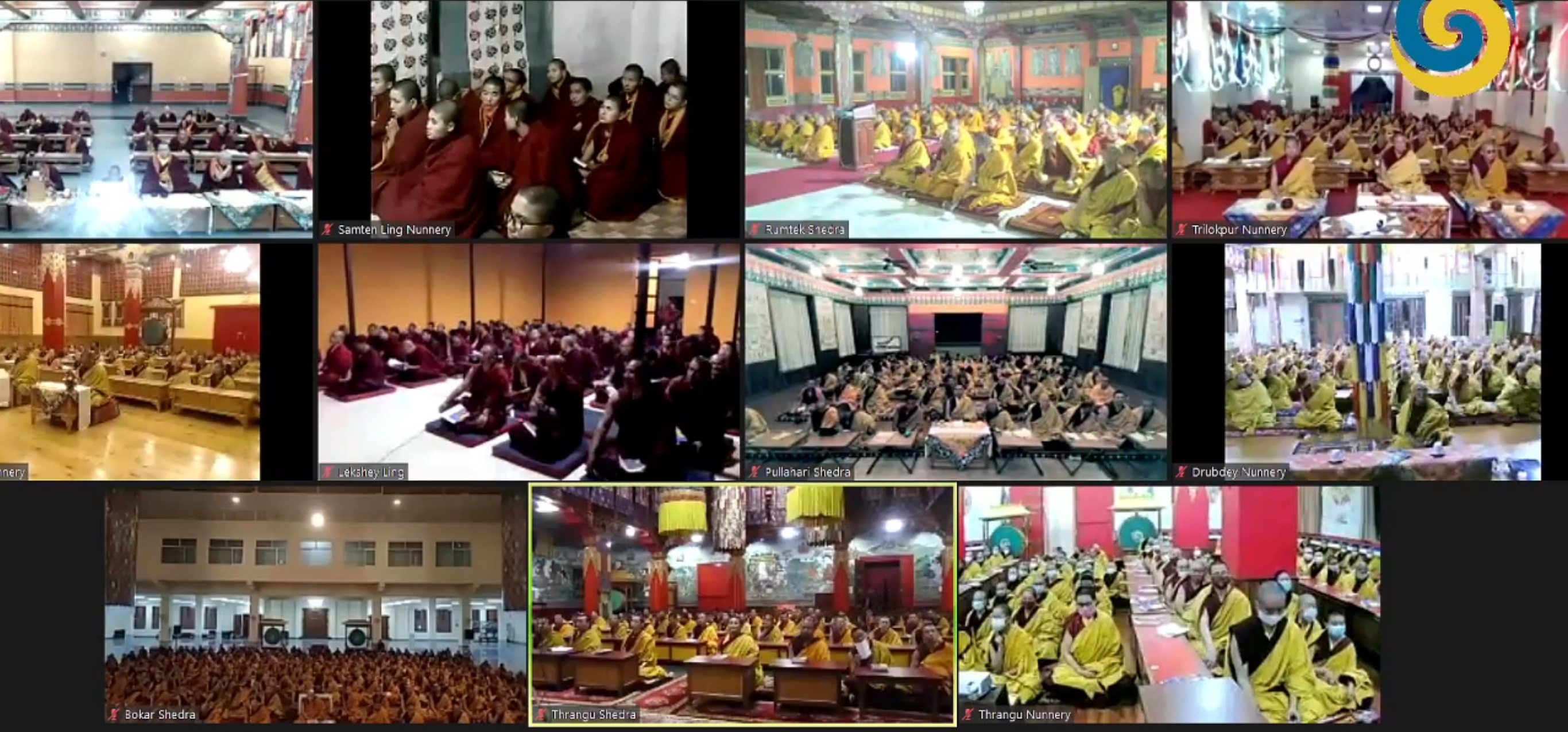
Youtube 视频
